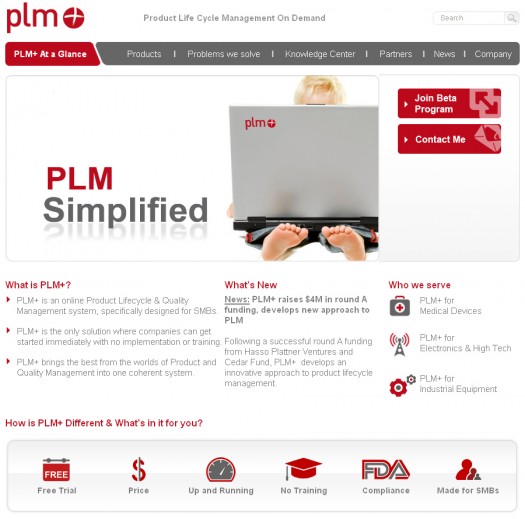
Product Lifecycle Management (PLM) is renowned for it’s complex implementation and lengthy training period. So, what if PLM were simple? Something that you didn’t have to implement. Something that you didn’t have to maintain. Something that could be accessed from (almost) anywhere. That is the aim of PLMPlus.
We had a heckuva phone conversation with Benny Shaviv yesterday and got the scoop on his fresh new venture, which by the way, recently received $4 Million in round A funding. Looks like someone thinks they’re stirring things up a little. We do too. So, we slammed Benny a very relevant case study type of question… that didn’t even phase him at all. He may be a robot, but most likely he really understands what his biz is about. Take a look.
Imagine this. A company has engineering in one location and production in another location. Engineering uses SolidWorks. Production uses an Enterprise Resource Planning (ERP) system to organize/track/order parts and material. They want to optimize how each location works together. How can PLM+ help this?
As for PLM+, two problems we aim to solve are the interface between R&D and Manufacturing and enabling multi-location design.
In a nutshell: For this scenario, PLM+ serves as the backbone that drives the processes between multi-geographical teams and between R&D and manufacturing. For example, the R&D team in Colorado puts in a change to a product and an Engineering Change Order (ECO) is created, which is also visible by the manufacturing leader in Detroit (or Barcelona, or Taipei). He gets the ECO delivered automatically, has all the associated data, signs off on it, and its subsequently approved for manufacturing. At any time – any member of any team (with proper role permissions assigned) can access any part of the data or its associated documents to get any information they need.
On the PLM+ backend, final manufacturing data is transferred to the ERP. The same would work for any type of process (ECO, MCO, etc) and all of this also applies to 2, 3, or more distributed design teams in different locations that run development processes between them. At any time – the system gives full visibility as to where things stand on each process, what are the actions remaining to completion, and what the bottlenecks are.
The main point to keep in mind here is that organizations that are distributed have a very hard time training remote employees, and this is something that always inhibits system deployment. If you have multiple locations each of them with 2-3 people, what are your chances of training and supporting the people on a traditional system? Take that, as opposed to a system that is meant to be intuitive and self-trainable.
With PLM+ being a web-based solution, how is data secured?
Great and common question. There are three perspectives this includes:
User access: PLM+ uses personal licenses & role based security – users are only allowed to access data that has been made available to them by their administrator via the role that was defined for them. They are only exposed to what they need to see and nothing else. Same of course goes for suppliers.
Application hardening perspective: PLM+ has multiple security mechanisms employed on the application & its network to ensure no loopholes or vulnerabilities to malicious attacks. We also hired a third party expert company to conduct penetration testing.
Hosting perspective: PLM+ hosts the application & data in a data center that is carrier grade (meaning that they exceed global telecom standards) and are SAS 70 Type II certified. They have very strict security & availability mechanisms & policies including: electronic security mechanisms & enforcement, redundant network connections, redundant backups, redundant power sources, enhanced sprinklers & HVAC systems, guarded physical access and lot more. Some of the world’s largest companies host their data there.
If we take a step back and look at the big picture – no small/medium company would be able to afford THIS type of security on its own locations.
Will ‘PLM in the Cloud’ Work?
For me, if it’s a web-based solution, with no implementation, minimal training and reasonable cost, it’s attractive. Many, however, still have the old (somewhat valid) security paradigm in their head. Meeting certifications and standards help, but it’s in our natures to store data in our own little box and think it’s safer there. If a solution is familiar to enough people though, the mental barriers that restrict it’s use tend to crumble. With everyone talking cloud apps these days and wi-fi spreading out to the far reaches of earth and sky, I’m thinking we’ll soon wake up with no barriers in sight.
PLM+ is currently in closed beta. You can sign up here. As more leaks out on the backend and how it actually functions, we’ll be sure to let you know. In the meantime, start to enjoy the idea that PLM may be becoming a bit more accessible for smaller companies.
Once again, Al Dean of Develop3D beat me to the punch on this story. For his perspective check out his Develop3D blog post. And like Al mentions, Twitter brings business discussion down to a more understandable, more enjoyable, personal conversation. I came about meeting Benny Shaviv on Twitter. You can too, as well as SolidSmack, Al Dean and many others.




